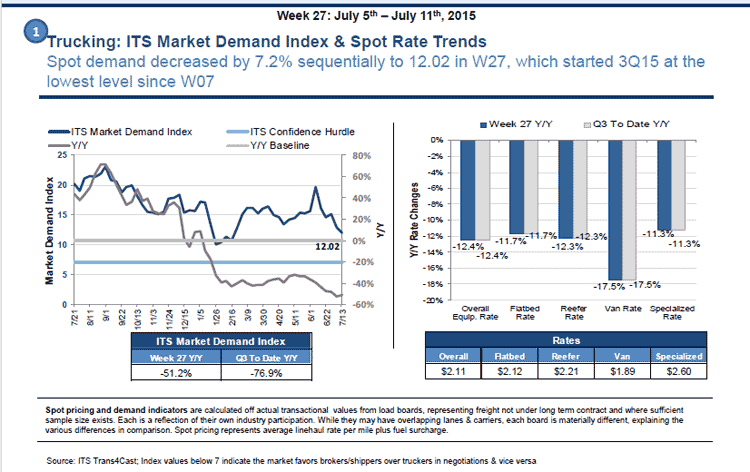Larkin Says: |
 |
| The ITS Market Demand Index (MDI) fell by 7.2% to 12.02 in W27, which was the lowest level seen since the first six weeks of the year. |
|
What Do You Say?
|
|
|
|
New Expert Insight Column on SCDigest: We have partnered with Stifel Financial Corp. to publish its weekly recap of the week in transportation, written by well-known analyst John Larkin. Check the SCDigest home page each Monday morning for the latest edition.
Takeaways from This Week's Fundamental Research
This week began with the railroad bellwether, CSX (Hold, $32.18), beating consensus estimates ($0.53 Street and Stifel est., $0.56 GAAP EPS, $0.54 adj. EPS), and Marten Transport (MRTN, Hold, $19.20) disappointing with contractions in their legacy logistics segment ($0.30 Street est., $0.28 Stifel est., $0.25 actual EPS).
CSX benefitted from moderately improved service and gained efficiencies throughout the quarter. Marten's legacy truckload business was close to as expected with a 9.1% y/y revenue ex-fuel surcharge growth rate and a 90.3% operating ratio, this generally matches with our hypothesis about a strong contract market and a challenged spot environment.
The week ended with KSU (Sell, $98.60) matching a Street consensus, which was low because the previous 2Q15 estimate was $1.16, and J.B. Hunt beating the Street on an adjusted basis (Street $0.90, GAAP EPS $0.88, adj. EPS $0.95). KSU continues to struggle with volumes as both economic headwinds challenge growth and internally controlled service metrics inhibit growth from within the consumer oriented spaces of intermodal and automobiles.
J.B. Hunt (JBHT, Hold, $84.69) showed strong growth in volume and pricing across each of their core segments and their GAAP miss was solely predicated on a one time corporate wide streamlining and technology redevelopment cost.
We currently hold Buy-rated names on five equipment manufacturers/leasing companies [(TRN, $25.83), (RAIL, $20.91), (WNC, $12.01), (ALSN, $29.32), (R, $91.49)], three truckload companies [(SWFT, $23.15), (CGI, $21.55), (KNX, $27.90)], three less-than-truckload companies [(CNW, $36.92), (SAIA, $39.84), (ODFL, $67.89)], one railroad [UNP, $97.42], one short line railroad holding company [GWR, $73.03], one logistics company [XPO, $46.37], and one passenger transport play [STB, $4.54].
Previous Columns by
John Larkin |
|
|
Key Insights from the Analysis of Industry Data Feeds
Trucking & Logistics:
In week 27, which was the first week of 3Q15 and the first full week after the July 4th holiday, spot demand weakened across the board. The ITS Market Demand Index (MDI) fell by 7.2% to 12.02 in W27, which was the lowest level seen since the first six weeks of the year. Load-to-truck ratios on DAT declined as load availability lagged behind recovered capacity. Sequentially, the refrigerated ratio fell 21.9% to 5.0, dry van fell 16.7% to 2.0, and flatbed fell 14.5% to 14.2.
Similarly, DAT spot rates also dropped lower this week. Reefer dropped three pennies to $2.19 per mile, and flatbed and dry van each lost two cents this week ending at $2.16 and $1.87, respectively. Weekly average equipment rates all fell this week as well - the overall equipment rate dropped 3.2% to $2.11 and the refrigerated, dry van, specialized, and flatbed rates fell 8.3%, 7.4%, 3.3%, and 1.4%, respectively.
Demand (MDI) continued its downward trend below the 5-year moving average. For reference, index values below 7.0 indicate the market favors brokers/shippers over truckers in negotiations and vice versa, so the market still remains in pro-carrier territory (W27 ended at 12.02). W27 is down around 20.1% when compared to the comparable week in 2013 (which had more normalized levels than 2014). Compared to the inflated levels in 2014, however, this week's MDI index was down around 56.0%

Rail:
Total unit volume (i.e., commodity carloads and intermodal units) in W27 was up across the board for a total sequential increase of 2.8% this week following a 2.9% decrease in W26. The strongest performer of the week was CP, whose total unit volume was up 7.0%; the weakest performer of the week was CN and UNP, whose total unit volumes were up only 1.0% and 1.1% respectively.
Total commodity carloads were largely positive (4.1% increase in W27) following a largely negative week in W26. The weakest performers were CN and UNP, which showed slight decreases (0.7% and 0.3%, respectively) this week. The leader of the group was NSC, which had a 9.5% increase this week. Intermodal carloads also increased by 1.1% this week - the only rails with negative intermodal volumes this week was CSX and KSU, which declined 6.0% and 2.2%, respectively. The strongest performer in this category was CP, which increased its intermodal volume by 8.9% this week.
Across Class I's as a whole, intermodal containers, grain, and coke were up the most this week y/y. Similarly to the rest of the quarter, most Class I rails have suffered from weak coal volumes, which have persisted for the last quarter due to regulations and a soft U.S. dollar. This week y/y, notable weaknesses included coal for NSC, CSX, and UNP and notable strengths included intermodal containers for BNSF and CN..
Class I performance metrics were mixed this week. On a weekly sequential basis, velocity increased about 2.0% overall. In fact, the only rail with a decrease in velocity was KSU (down 3.1%), which also lowered its velocity 4.8% the week prior. Terminal dwell, however, unfavorably increased by 3.0% due to some large increases in UNP, CSX, and BNSF this week (9.8%, 6.4%, and 3.9%, respectively).
Sequentially this week, the rails have decreased their cars on-line by about 0.4%, and decreased them by about 0.8% y/y. In y/y terms, the rails have cut out around 9,100 cars on-line relative to last year. Finally, overall asset efficiency is down from last quarter, although it is up by 3.3% sequentially. On a total y/y basis, more cars on-line have been required to move a like-for-like number of goods
Any reaction to this week's note? Let us know your thoughts in the Feedback area below. |